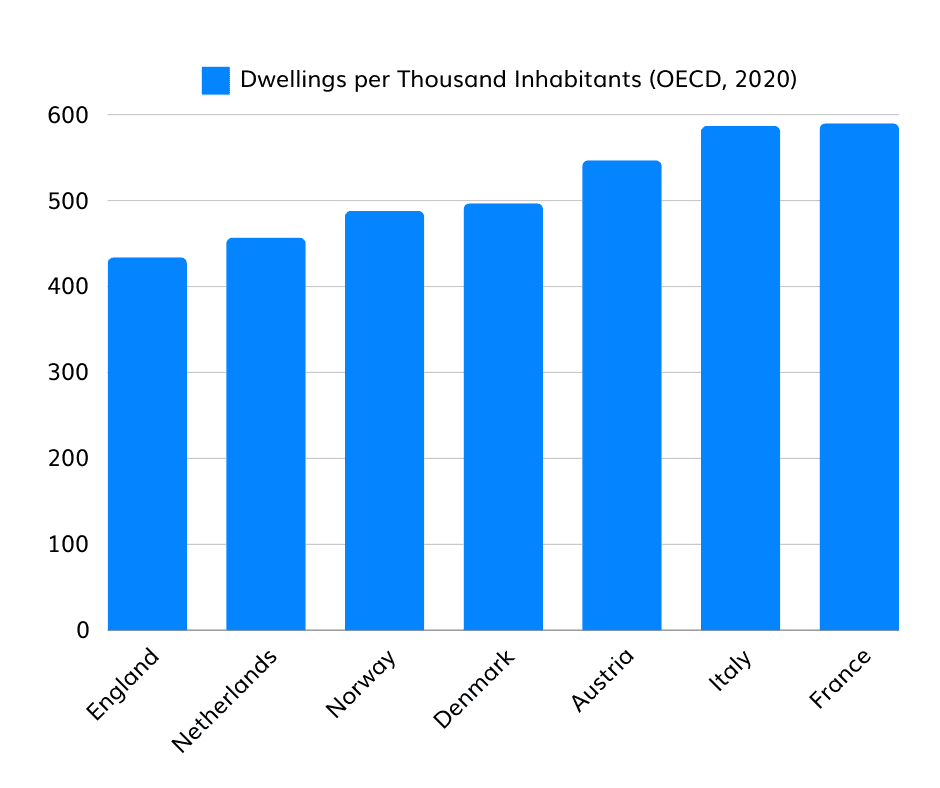The UK ranks among the least affordable places in Europe for buying or renting a home. House prices consistently outpace incomes, making it increasingly unlikely for many aspiring homeowners to achieve their goals. This not only affects their financial stability but also their sense of security and belonging. Leading up to the general election on 4th July 2024, Kier Starmer’s team made several commitments to UK voters regarding their strategy to address the country’s housing crisis. This article delves into the state of the UK housing market, drawing on expert analysis to evaluate its current condition, and examines the proposals of the new Labour government to tackle these challenges. We assess the realism of these plans and their potential effectiveness in resolving the issue.
Labour and Housing: UK in comparison to the rest of Europe
Data from the Organisation for Economic Cooperation and Development (OECD) paints a dismal picture of the UK housing market when compared to other European nations, with England specifically rated as the most challenging place in the developed world to find a home.
England: Dwellings per Thousand Habitants
England lags behind other European nations in terms of the number of homes available per thousand people in the population. This shortage is primarily attributed to issues such as availability, pricing, and a persistent undersupply of new housing. As a result, many people are forced into shared living arrangements due to limited alternatives.

Data from the OECD shows that for every 1000 people, England has just 434 dwellings. This is considerably less than other similar-sized European economies, such as the Netherlands (457), Norway (488), Denmark (497), Austria (547), Italy (587), and France (590).
UK: The Oldest Housing in Europe
The number of new homes being created in the UK has steadily improved since 2014, but historically, our record is low. Only 7% of our homes have been built since 2001, and we have the highest proportion of houses built before 1946 in Europe (38%). This means that of the options available, houses are often in poor condition, less able to withstand adverse weather conditions and less energy-efficient. In turn, our energy bills are among the highest in Europe, currently standing at around 5% of the average salary (£1,646).

Despite decades of promises from changing governments, the UK consistently fails to meet new-build targets. According to the National House Building Council (NHBC), the number of new homes built in the first quarter of 2024 alone decreased by 20%. Reasons given for the fall range from rising interest rates to a lack of skilled workers to complete the builds to unfavourable weather conditions.
Labour made several housing promises leading up to the general election, but fulfilling those promises may depend heavily on factors beyond their control or require significantly more planning and consideration to ensure success.
Labour and Housing: The Election Promises
Before the general election, we put together a full round-up of Labour promises on housing. These were:
Housing Supply
Labour promised ‘Get Britain Building Again’, pledging 1.5million new homes in its first term and the creation of new towns to accommodate them.
A Strategic Review of the Green Belt
Labour promised ‘Get Britain Building Again’, pledging 1.5million new homes in its first term and the creation of new towns to accommodate them.
First-time Buyers
Over and above a help-to-buy scheme, Labour announced controversial plans in 2022 to give first-time buyers first refusal on all new-build houses.
Affordable Housing
Labour pledged the biggest boost in affordable housing in a generation, increasing the number of affordable homes built each year. This includes plans to crack down on developers who try to evade their affordable housing obligations and more support for local authorities.
Short-term lets and Holiday Homes
In 2022, Labour first hinted at introducing a UK-wide licensing system for short-term lets. This system aims to provide local authorities with the data needed to assess the impact on the local economy. The plans also include a Right-to-Buy scheme, offering communities first refusal on properties of community value that are either up for sale or in disrepair.
Renting
Labour wants to introduce a Renters’ Charter, which would see an end to no-fault evictions, give tenants the right to make reasonable alterations to a property or own pets, and introduce an extended four-month notice period for eviction. It would also disallow automatic evictions for rent arrears. communities first refusal on properties of community value that are either up for sale or in disrepair.
Tax
Labour claims it aims to make the tax system more equitable by reforming council tax and implementing a land value tax. It also announced plans to increase the stamp duty surcharge for overseas buyers.
Regulation
In response to the Grenfell Tower tragedy, Labour wants to introduce a new set of minimum standards to be enforced through nationwide licensing. They also promise tougher consequences for landlords who continue to operate outside of the rules.
Labour and Housing Targets: Problems and Impact
“The extreme damage caused by unaffordable housing, not just as it restricts access to decent housing but because of the harm it does to equality and social cohesion, is now part of our common discourse. In 2021 to 2022, housing was the largest component of household spending, at 17.5%. The poorest 30% of households spend proportionately twice as much as the richest 10%. House price inflation has overwhelmed all other price increases and hits the poorest the hardest. The increase in the real price of houses redistributes wealth to homeowners, driving a wedge between the old and the young and eroding our social fabric. Less widely discussed is the damage our dysfunctional planning system does the wider economy.”
Paul Cheshire, London School of Economics & Political Science
Labour’s housing plans are the most ambitious in fifty years, aiming to build 1.5 million new homes and reinstate compulsory housebuilding targets for local councils. While this would address the UK’s severe housing shortage, implementing these targets will likely be challenging. Currently, local authorities are responsible for planning and identifying land for development, a task that only a third have successfully completed. Michael Gove, former housing secretary, relaxed housing targets last year in reaction to pressure from Tory backbenchers. This gave councils the power to ignore them if they were thought to undermine the area’s character.
In the King’s Speech, delivered on Wednesday, July 17th, the Prime Minister reinstated mandatory targets, insisting that local authorities work together to assess regional infrastructure needs in a bid to prevent individual authorities from blocking plans. Local housing plans and local growth plans where consideration has been given to supporting industry and economy are also part of the bill.
Another manifesto headline providing hope for the housing market is the pledge to build a generation of new towns. Taking inspiration from the Labour government of 1945, Starmer’s team likely want to emulate the process – giving authority to public development corporations. However, three previous attempts to resurrect this idea have failed due to a lack of robust planning and agreement regarding land value. Compulsory purchase powers to acquire land at its existing use value (rather than at “hope” value with the potential for building plans factored in) have historically fizzled away to nothing as landowners waited patiently for a change in government. Labour will need to implement strong and strict policies to impose land acquisition decisions or risk failing at the first hurdle.
Labour has also committed to a strategic review of the UK’s Green Belt, acknowledging that some areas will need to be released for development to meet the demand for new homes. Releasing small pockets of land with no environmental value near major commuter stations is, some argue, an effective part-solution to a significant housing issue. However, others remain concerned about the plans.
"The Green Belt is the countryside next door for 30m people in the UK and has huge benefits for food security, physical and mental health, and nature restoration. Protections for it must be maintained in the policy framework. New homes on the Green Belt have rarely been genuinely affordable and create car-dependent communities far from public transport networks and other essential infrastructure."
Elli Moody, CPRE Director of Policy, Campaigns and Communications
Overall, Labour has some exciting plans to boost the housing market, but if they are to succeed, they will need to back them up with meticulous planning and a willingness to solve issues of resource and underfunding across the country.
What does this mean for mortgage lenders?
Currently, interest rates remain a significant barrier for people looking to buy a new home, meaning the immediate future of lending is largely with the Bank of England rather than the government. But what about over the next five years?
If Labour can fulfil their election pledge of 1.5 million new dwellings over their first term, this could result in an extra 65,000 coming to the market each year (using 2023 as the benchmark at 235,000). With the influx of choice, house prices are likely to stop rising as quickly as they have been, making homeownership theoretically more achievable for people looking to buy.
In addition, Labour’s proposed “Freedom to Buy” scheme would make the mortgage guarantee scheme permanent, helping 80,000 young people onto the property ladder.
Labour’s policies can potentially boost investor confidence, maintaining economic stability. Economists believe that if Labour maintains tight fiscal policies, this could facilitate a gradual decline in inflation, allowing the Bank of England to cut interest rates and make borrowing cheaper.
With new hope for the housing market, lenders have an opportunity to rethink and reshape customer journeys, focussing on education and empowerment. If Labour’s vision is to supply new homes and help people find a sense of belonging, lenders’ vision should be to shore up that opportunity with resources and support.


